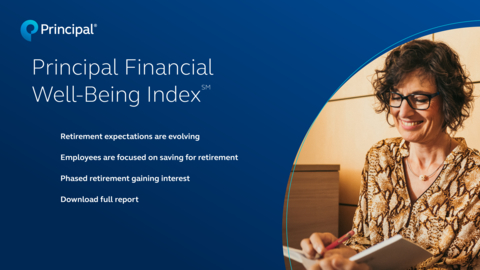Retirement Expectations Evolve as Workforce Ages According to Principal® Survey
New research finds employees are prioritizing saving for retirement as their views on how and when to retire changes

Our third wave of insights. (Graphic: Business Wire)
Phased retirement appeals to younger workers who want to retire earlier
According to the Principal Financial Well-Being IndexSM, among Americans in the workforce, gradually decreasing hours is the most desired way to retire (
“Attitudes and expectations for retirement continue to evolve, and we expect the desire to approach retirement in phases will continue to grow with future generations,” said Chris Littlefield, president of Retirement and Income Solutions at Principal®.
While there are some similarities in how generations want to retire, they have different expectations on timelines and the age at which they plan to retire. The youngest generation, Gen Z, expects to retire at 55 – approximately 10 years earlier than baby boomers (68) and Gen X (64), and four years sooner than millennials (59).
Employees prioritize saving for retirement
The survey revealed employees are focused on balancing basic needs with long-term savings outcomes against a backdrop of ongoing economic pressures that continue to top their list of concerns. Employees of all generations ranked saving for retirement as their top financial priority, followed by affording basic needs and paying off consumer debt3.
"Saving for retirement is the No. 1 financial priority for employees surveyed, which validates that access to workplace benefits and financial wellness programs is helping Americans save for retirement and achieve better financial outcomes,” Littlefield said. “Going forward, increased personalization as well as tailored savings and investment strategies that take into account an individual’s financial goals, lifestyle, health care needs, dependent care obligations, retirement income expectations, and other unique factors will help achieve improved financial security in retirement.”
Retention and recruitment of older employees critical for business success
Employee interest in phased retirement has added value for employers. Most employers (
Despite this, not all employers have experience with offering phased retirement. Only
See all results and insights from the latest Principal Financial Well-Being IndexSM (PDF).
1According to the Alliance for Lifetime Income 2This wave included a survey of 137 individuals between the ages of 50 and 75 who consider themselves retired or have previously fully retired and gone back to work. 3In order to be included in the survey sample, employees must work full-time, and their employer has to offer either health insurance or retirement as an employee benefit. 4Businesses with 2-499 employees 5Businesses with 500-10,000 employees |
About the Principal Financial Well-Being IndexSM
The Principal Financial Well-Being IndexSM surveys business owners, decision makers and business leaders aged 21 and over who work at companies with 2-10,000 employees and offer either health insurance or retirement as an employee benefit. The nation-wide survey, commissioned since 2012, examines the financial well-being of American workers and business employers. In 2020, the Well-Being Index was transformed from an annual survey to a regular pulse, offering three waves, revisiting questions and measuring sentiment regarding timely issues in the small and midsized business marketplace. In the first pulse of the Well-Being Index in 2022, the employee audience was added to the survey to compare and contrast key sentiment from employers. The survey was commissioned by Principal® and conducted online by Dynata from November 6-13, 2023, with a total of 500 business owners, decision makers and business leader participants and a total of 200 employee participants. This wave included a survey of 127 individuals who consider themselves retired or have previously fully retired and gone back to work. The research report focuses on providing a holistic perspective on key trends and timely issues in the small and medium business market.
About Principal Financial Group®
Principal Financial Group® (Nasdaq: PFG) is a global financial company with 19,500 employees1 passionate about improving the wealth and well-being of people and businesses. In business for more than 140 years, we’re helping more than 61 million customers1 plan, protect, invest, and retire, while working to support the communities where we do business, and build a diverse, inclusive workforce. Principal® is proud to be recognized as one of the 2023 World’s Most Ethical Companies® by Ethisphere2, a member of the Bloomberg Gender Equality Index, and a “Best Places to Work in Money Management3.” Learn more about Principal and our commitment to building a better future at principal.com.
1 As of September 30, 2023 |
2 Ethisphere, 2023 |
3 Pensions & Investments, 2023 |
Dynata is not an affiliate of any company of the Principal Financial Group®
Insurance products issued by Principal National Life Insurance Co (except in NY) and Principal Life Insurance Co. Plan administrative services offered by Principal Life. Principal Funds, Inc. is distributed by Principal Funds Distributor, Inc. Securities offered through Principal Securities, Inc., member SIPC and/or independent broker/-dealers. Referenced companies are members of the Principal Financial Group®,
© 2024 Principal Financial Services,
View source version on businesswire.com: https://www.businesswire.com/news/home/20240110445435/en/
Ashley Miller, miller.ashley@principal.com, 515-878-6295
Source: Principal Financial Group







